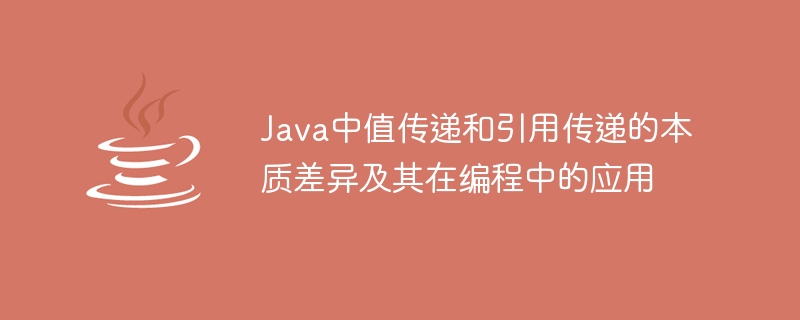

The essential difference between value passing and reference passing in Java and its application in programming
In Java programming, we often use value passing and reference passing These two delivery methods. Although they can both pass data, their essential differences lead to very different applications in programming. This article will explain in detail the essential differences between passing by value and passing by reference, and give examples of their application in programming.
Pass by value means that when a method is called, the actual parameter copies its value to the formal parameter, that is, the formal parameter obtains a copy of the actual parameter value, while the value of the actual parameter itself remains constant. In value transfer, any modification to the formal parameters will not affect the actual parameters.
The following is a simple example to illustrate the characteristics of value transfer:
public class ValuePassingExample {
public static void main(String[] args) {
int num = 10;
System.out.println("Before method call, num is: " + num);
modifyValue(num);
System.out.println("After method call, num is: " + num);
}
public static void modifyValue(int value) {
value = 20;
System.out.println("Value in method is: " + value);
}
}The output result is:
Before method call, num is: 10 Value in method is: 20 After method call, num is: 10
It can be seen from the output result that although in modifyValue The value of the formal parameter value is modified in the method, but it has no effect on the value of the actual parameter num. This is the characteristic of value passing.
Pass by reference means that when a method is called, the reference address of the actual parameter is passed to the formal parameter. The formal parameter and the actual parameter point to the same object. Any modification to the formal parameter will affect The actual parameter itself.
The following is a simple example to illustrate the characteristics of reference passing:
public class ReferencePassingExample {
public static void main(String[] args) {
StringBuilder builder = new StringBuilder("Hello");
System.out.println("Before method call, builder is: " + builder);
modifyReference(builder);
System.out.println("After method call, builder is: " + builder);
}
public static void modifyReference(StringBuilder reference) {
reference.append(" World");
System.out.println("Reference in method is: " + reference);
}
}The output result is:
Before method call, builder is: Hello Reference in method is: Hello World After method call, builder is: Hello World
As can be seen from the output result, in modifyReferenceThe reference reference is modified in the method, and this modification also affects the actual parameter builder. This is the characteristic of passing by reference.
Understanding the essential difference between passing by value and passing by reference is very important for programming. In actual development, we can choose the appropriate delivery method according to different needs.
For simple basic data types, just use value passing. Because the value of a basic data type does not change, there is no need to use reference passing. For complex objects, using reference passing can improve program performance and efficiency.
In addition, when we need to change the object attribute value, we also need to pay attention to the delivery method. If you only need to modify a certain property of the object, you can use pass by reference. But if you need to reallocate a new object, you need to use the return value method instead of modifying the incoming object.
To summarize, understanding the essential differences between value passing and reference passing and their application in programming is crucial to improving code quality and performance. Reasonable selection of delivery methods can make the program clearer and more readable, and improve the efficiency of the code.
The above is the detailed content of Basic differences between value passing and reference passing in Java and analysis of their application in programming. For more information, please follow other related articles on the PHP Chinese website!




